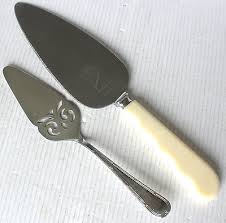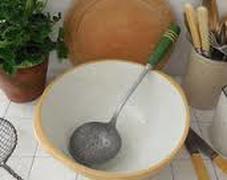|
Knives, forks and spoons used for either eating or serving food are referred to as silverware. These utensils do not need to be made out of silver, but they should not be plastic. Most silverware, also known as flatware, is made of stainless steel, silver plate or sterling silver. The latter is very costly, and if you own or have inherited any sterling silver pieces, by all means use them, even if they do not match the rest of your flatware.
As we have pointed out, the British Victorians designed a stunning array of clever flatware for specific purposes such as pickle forks, butter knives, jam spoons, and so on. Many of these items can be found in antiques and second hand stores today, and it’s fun to include a few of these when hosting Afternoon Tea. They do not need to match your everyday flatware, as they have a charm all their own. While specialized Victorian silverware is delightful, it is not really necessary. A teaspoon, a small salad sized fork and a small butter knife for each guest would be the ideal combination for Afternoon Tea. If you do not have salad forks and butter knives, just use the larger dinner forks and dinner knives that you use for ordinary meals instead. The teaspoon is used to stir the tea after milk or sugar has been added. It then rests on the saucer. The host will provide a separate spoon, perhaps a Victorian sugar spoon, to accompany the sugar bowl. The guest should use that spoon to add sugar to her tea, then stir with her own teaspoon, which should never be inserted into the sugar bowl while it is wet with tea. Neither should the sugar bowl spoon be used for stirring tea, as it will cause the sugar to clump when it is used again to add sugar to a teacup. Small knives and forks are preferred for Afternoon Tea because the foods served are small. While most Afternoon Tea food, such as finger sandwiches, scones and cookies, are meant to be eaten with the fingers, other food items, such as cakes and trifle, will require a fork. A small knife such as a butter knife is helpful in adding butter, jam or clotted cream to a scone. The host will provide a butter knife and spoons with the jam pots, butter dish and clotted cream bowl. These should be used to transfer these condiments to the guest’s plate, not for spreading directly onto the scone. Once the butter or jam has been placed on the plate, the guest carefully breaks the scone apart with her fingers and applies the butter, jam or clotted cream with her own butter knife, not the serving knife. Her used butter knife can then rest on the edge of her plate and can be reused for adding condiments to a second scone. The idea is that each guest’s knife, fork and spoon only touch her own food, creating a comforting sense of cleanliness. The host will provide silverware for serving the foods offered at Afternoon Tea. These items might include a large, pierced spoon for serving fruit salad, a triangular trowel-like implement for cutting cake or pie and lifting a piece onto one’s plate, a small specialized knife for slicing cheese and placing it on a plate, etc. Finger sandwiches, as their name suggests, can be retrieved from the serving plate with the guest’s fingers, as can scones, cookies and small pastries. However, the host should place the appropriate implement next to the serving bowl or plate containing food that might make a mess on the guest’s fingers. With potentially very messy foods, such as trifle, the host should place a small plate under the large spoon or other utensil to prevent the tablecloth from being soiled. |
- Home
- About/Blog
-
The Tea Book
- The Road Back to Civilization
- A Brief History of Tea
- Philosophy of Tea >
- Guidelines for the Host/Hostess >
- Guidelines for the Guest >
- A Checklist for Planning a Tea Party
- Teas of the World and How to Make Tea >
- Tea Utensils and Accessories >
- Tea Menu Basics >
- Afternoon Tea and the Four Seasons >
-
A Calendar of Tea Parties
>
- January: A Japanese New Year’s Tea
- February: A Valentine’s Day Tea
- March: A St. Patrick’s Day Irish Tea
- April: An Easter Tea
- May: A Mother’s Day Tea
- June: A Wedding Reception Tea >
- July: A Picnic Tea
- August: A Family Reunion Tea >
- September: An Ozark Farm Harvest Tea
- October: A Tea to Honor Our Ancestors (Dia de los Muertos)
- November: A Post Thanksgiving Tea
- December: A Christmas Tea >
- A World of Tea Parties >
- Afternoon Tea for Special Occasions >
- Purchase Recipes
- Resources







